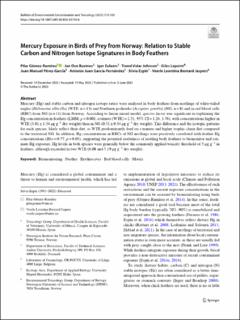| dc.contributor.author | Gómez-Ramírez, Pilar | |
| dc.contributor.author | Bustnes, Jan Ove | |
| dc.contributor.author | Eulaers, Igor | |
| dc.contributor.author | Johnsen, Trond Vidar | |
| dc.contributor.author | Lepoint, Giles | |
| dc.contributor.author | Pérez-García, Juan Manuel | |
| dc.contributor.author | García-Fernández, Antonio Juan | |
| dc.contributor.author | Espín, Silvia | |
| dc.contributor.author | Jaspers, Veerle Leontina B | |
| dc.date.accessioned | 2024-01-18T12:07:36Z | |
| dc.date.available | 2024-01-18T12:07:36Z | |
| dc.date.created | 2023-06-23T14:28:47Z | |
| dc.date.issued | 2023 | |
| dc.identifier.issn | 0007-4861 | |
| dc.identifier.uri | https://hdl.handle.net/11250/3112478 | |
| dc.description.abstract | Mercury (Hg) and stable carbon and nitrogen isotope ratios were analysed in body feathers from nestlings of white-tailed eagles (Haliaeetus albicilla) (WTE; n=13) and Northern goshawks (Accipiter gentilis) (NG; n=8) and in red blood cells (RBC) from NG (n=11) from Norway. According to linear mixed model, species factor was signifcant in explaining the Hg concentration in feathers (LMM; p<0.001, estimate (WTE)=2.51, 95% CI=1.26, 3.76), with concentrations higher in WTE (3.01±1.34 µg g−1 dry weight) than in NG (0.51±0.34 µg g−1 dry weight). This diference and the isotopic patterns for each species, likely refect their diet, as WTE predominantly feed on a marine and higher trophic-chain diet compared to the terrestrial NG. In addition, Hg concentrations in RBCs of NG nestlings were positively correlated with feather Hg concentrations (Rho=0.77, p=0.03), supporting the potential usefulness of nestling body feathers to biomonitor and estimate Hg exposure. Hg levels in both species were generally below the commonly applied toxicity threshold of 5 µg g−1 in feathers, although exceeded in two WTE (6.08 and 5.19 µg g−1 dry weight). Biomonitoring · Feather · Erythrocytes · Red blood cells · Metals | en_US |
| dc.language.iso | eng | en_US |
| dc.publisher | Springer Nature Ltd. | en_US |
| dc.rights | Navngivelse 4.0 Internasjonal | * |
| dc.rights.uri | http://creativecommons.org/licenses/by/4.0/deed.no | * |
| dc.title | Mercury Exposure in Birds of Prey from Norway: Relation to Stable Carbon and Nitrogen Isotope Signatures in Body Feathers | en_US |
| dc.title.alternative | Mercury Exposure in Birds of Prey from Norway: Relation to Stable Carbon and Nitrogen Isotope Signatures in Body Feathers | en_US |
| dc.type | Peer reviewed | en_US |
| dc.type | Journal article | en_US |
| dc.description.version | publishedVersion | en_US |
| dc.subject.nsi | VDP::Zoologiske og botaniske fag: 480 | en_US |
| dc.subject.nsi | VDP::Zoology and botany: 480 | en_US |
| dc.source.volume | 110 | en_US |
| dc.source.journal | Bulletin of Environmental Contamination and Toxicology | en_US |
| dc.source.issue | 100 | en_US |
| dc.identifier.doi | 10.1007/s00128-023-03740-6 | |
| dc.identifier.cristin | 2157523 | |
| dc.relation.project | Framsenteret: Hazardous Substances Flagship (the Raptor project) | en_US |
| dc.relation.project | Andre: University of Murcia | en_US |
| dc.relation.project | Andre: Universidad Complutense de Madrid: EEA Financial Mechanism | en_US |
| dc.relation.project | Egen institusjon: NTNU | en_US |
| dc.relation.project | Norges forskningsråd: xxxxxx | en_US |
| dc.relation.project | Andre: Ministerio de Ciencia, Innovación y Universidades | en_US |
| cristin.ispublished | true | |
| cristin.fulltext | original | |
| cristin.qualitycode | 1 | |

